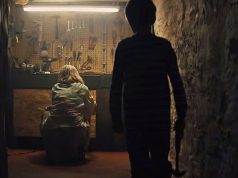You can usually tell by a film’s description whether it’s something you might be interested in seeing. You don’t need a critic for that; nobody knows better than you do when a movie is your “type.” All you need a review for (if you need one at all) is to tell you whether it’s a good example of the type of movie it is.
Case in point: “Maniac,” the new remake of a 1980 underground hit about a schizophrenic man who murders women. He murders them cruelly and bloodily, scalps them, then puts their hair on mannequins which he pretends are his girlfriends. Now, if that doesn’t sound like the sort of movie you’d be into, no matter how well it’s done, believe me, I will make no attempt to change your mind. Some movies transcend their genres — people who don’t usually like fantasy enjoy “Lord of the Rings”; people who aren’t into sports films love “Hoosiers” — but “Maniac” is not one of them. It is strictly for people who have a history of enjoying gory movies about psycho killers.
I count myself one of those people, and “Maniac” still comes up short, an intriguing exercise in technique without any real bite. It was directed by Franck Khalfoun from a screenplay by Alexandre Aja and Gregory Levasseur, and these three mad Frenchmen have collaborated before in different permutations (Khalfoun is usually an actor; Aja generally directs), including “High Tension” (2003) and the parking-garage thriller “P2” (2007). Aja and Levasseur were also responsible for the remakes of “The Hills Have Eyes” (2006) and “Mirrors” (2008). Basically, when it comes to new versions of existing horror films, these are your guys.
The new element they bring to “Maniac,” not found in the original, is that they show almost all of it through the killer’s eyes. The camera — and by extension the viewer — is the maniac. We see his hands a lot, but we only see his face when he looks in a mirror. There are a few exceptions to this, when the camera briefly takes the traditional omniscient point of view. These instances let us know that the action is truly, objectively happening, and isn’t a distortion of the killer’s fevered mind.
His name is Frank, and he’s played by professional hobbit impersonator Elijah Wood, he of the baby-blue eyes and the couldn’t-hurt-a-fly adorableness. These traits suit him well in the sense that psychopaths are creepier when they don’t look like psychopaths — but to be honest, it helps that we don’t see his face very often, either. Frank is a Norman Bates type, a troubled loser with severe mother issues (flashbacks reveal she was a hooker) who inherited the family business of mannequin sales and repairs and now occupies his time in the back room of the L.A. shop, playing house with his mannequin girlfriends.
Frank’s urge to kill, though tamped down by medication, gets the best of him and he begins using an online dating site to find and stalk young women. Separately from these endeavors, he meets a beautiful photographer named Anna (Nora Arnezeder) who wants to rent some of his mannequins for a gallery show. Thus begins the familiar tension over whether Anna will be another one of Frank’s victims, or whether she’ll be the one who saves him.
Shooting from the killer’s POV presents technical challenges that made “Maniac” harder to film than your average slasher flick. (Not least among them: how do you show Frank looking in the mirror without also showing the camera?) Khalfoun and his crew handle these difficulties seamlessly, and viewers who are interested in the craft of filmmaking might find that aspect compelling. The special makeup effects used to convey grotesque killings right before our eyes are also impressive.
But apart from those distinctions, there’s nothing about “Maniac” to set it apart from the countless other films about countless other psychos who kill countless other women. It isn’t more graphic or vicious than many of its genre-mates, and the psychology behind Frank’s actions is pretty humdrum, as these things go.
C (1 hr., 28 min.; )
Originally published at About.com.





